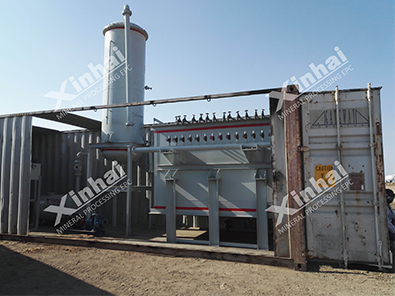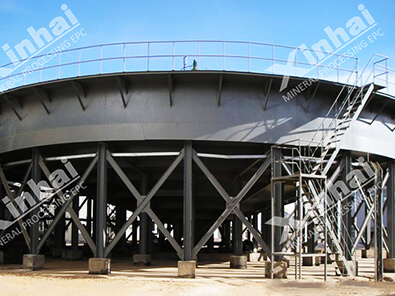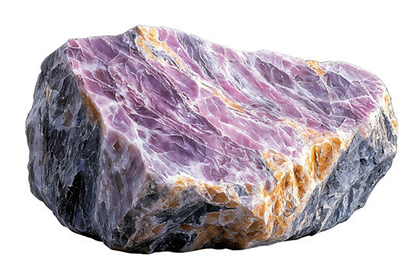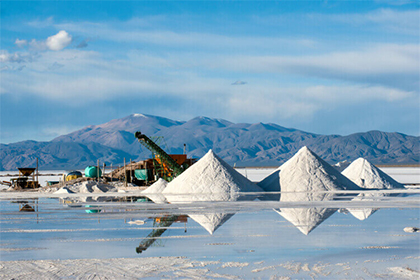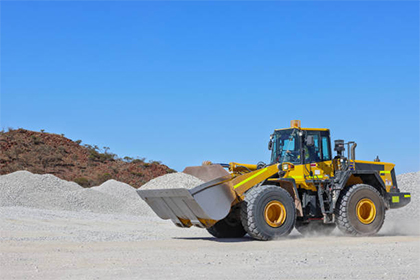What is Gold Cyanidation Process?
 Laura
Laura
 May 13, 2022
May 13, 2022
 2079
2079
If you want to know more details about equipment, solutions, etc, please click the button below for free consultation, or leave your requirements!

Gold leaching process machines with 5000tpd capacity
Gold cyanidation process refers to the method of extracting gold with cyanide as leaching solution. Since it was used in mines to extract gold and silver in 1887, it has a history of more than 200 years, and the technology is relatively mature. Cyanidation is still one of the main methods of gold production due to its high recovery rate, strong adaptability to ore, and the ability to produce gold in situ. This article will take you to understand the main classification of gold cyanidation process and the factors that affect the effect of gold extraction.
01 Main Classification of Gold Cyanidation Process
BackCyanation methods can be divided into two categories: stirring cyanation and percolation cyanation. Among them, stirring cyanidation is mainly used to treat flotation gold concentrate, or all-slime cyanidation; while percolation cyanidation is mainly used to treat low-grade gold-bearing oxide ores. Below we will introduce two aspects of stirring cyanation and percolation cyanation.
(1) Stirring Cyanidation
The stirring gold cyanidation process mainly includes two types of gold extraction processes, one is the so-called cyanide-zinc replacement process (CCD method and CCF method) in which the gold is recovered by replacing the precipitation with zinc powder (silk) after continuous countercurrent washing; The other type is the non-filtration cyanidation carbon pulp process (CIP method and CIL method) that directly absorbs and recovers gold from cyanide pulp without filtering and washing.
#1 Cyanide-Zinc Replacement Process
Cyanide-zinc replacement process (CCD method and CCF method) mainly includes leaching raw material preparation, stirring cyanide leaching, countercurrent washing solid-liquid separation, leachate purification and deoxidation, zinc powder (silk) replacement and pickling, smelting and ingot making, etc..
#2 CIP and CIL Process
The carbon slurry gold extraction process (CIP method and CIL method) is to put activated carbon into the cyanide pulp, adsorb the dissolved gold on the activated carbon, and then extract the gold from the activated carbon, which mainly includes the preparation of leaching raw materials, stirring leaching and countercurrent flow, carbon adsorption, gold-loaded carbon desorption, electrowinning, smelting and ingot making, carbon regeneration and other operations.
Carbon pulp method (CIP): First cyanide leaching, and then add activated carbon to adsorb gold in the pulp;
Carbon leaching method (CIL): Activated carbon is added to the leaching tank, and the leaching and adsorption are carried out at the same time, that is, soaking while absorbing.
(2) Percolation Cyanidation
The percolation cyanidation method is also one of the cyanidation leaching processes. It is based on the penetration of the cyanide solution through the ore layer to leaches the gold in the gold-bearing ores. It is suitable for placer and loose porous materials.
The percolation cyanide leaching method has two processes: pool leaching and heap leaching.
#1 Pool Immersion Process
The percolation leaching is generally carried out in the percolation leaching tank, and the leaching tank usually adopts a wooden tank, an iron tank tank or a cement tank. The bottom of the pool is horizontal or slightly inclined and is round, rectangular or square. The pool is equipped with a false bottom made of acid-resistant board with holes, the false bottom is covered with filter cloth, and the filter cloth is covered with a grid with wooden strips or corrosion-resistant metal strips. During leaching, the ore is placed in the pool, the leaching agent is added above the pool, and the leaching liquid flows out from the lower part of the false bottom. The false bottom is used to filter and support the ore.
#2 Heap Leaching Process
Heap leaching is mainly to transfer the mined ore to the prepared yard for stacking, or directly on the stockpiled waste rock or low-grade ore, spray or infiltrate with cyanide leaching solution to make the solution pass through the ore. In percolation and leaching, the leachate is circulated for many times, and the ore heap is sprayed repeatedly, then the leachate is collected, and then adsorbed by activated carbon or replaced with zinc, and the lean solution is returned to the heap leaching operation for recycling.
02 Influencing Factors of Gold Cyanidation Process
Back(1) Grinding Fineness
Generally speaking, the determination of grinding fineness is related to the characteristics of ore inlay. Different ore embedded form, gold particle size and form all have certain influence on the determination of grinding fineness.
(2) Slurry pH, Temperature, Stirring Speed
The reason why pulp pH value, pulp temperature and stirring speed affect gold leaching is that cyanide easily reacts in pulp to generate hydrocyanic acid (HCN), which is volatile and toxic. It will cause the loss of cyanide and also cause environmental pollution.
(3) Amount of Cyanide
Gold is a very inactive metal, and can undergo a complexation reaction with cyanide (CN-) under the action of oxygen during cyanidation leaching, resulting in a water-soluble cyanoaurite complex [Au(CN-) ) 2-], therefore, the dosage of cyanating agent is one of the key factors determining the dissolution of gold.
(4) Slurry Solid-Liquid Ratio
The pulp solid-liquid ratio is the pulp concentration. The pulp concentration will directly affect the diffusion rate of the components, which in turn affects the leaching rate and leaching speed of gold. It is recommended to determine the appropriate pulp solid-liquid ratio through beneficiation tests.
(5) Leaching Time
The cyanidation leaching of gold is a relatively slow process. The leaching time is generally more than 24h. The leaching rate of gold increases with the prolongation of leaching time, but the leaching rate of gold is continuously decreasing, and the leaching rate of gold gradually approaches. At a certain limit value, even if the leaching time is prolonged, the leaching rate of gold does not increase significantly.
(6) Air Volume
The reason for the need for aeration in gold leaching is that effective oxidation helps the dissolution of gold, so proper aeration can improve the solubility of oxygen in the pulp, thereby increasing the dissolution rate of gold. It is usually achieved by aerating or stirring the pulp.
03Summary
BackAccording to the above description, we have a general understanding of the classification of cyanidation gold extraction process and the influencing factors of gold extraction effect. However, in the actual application of gold cyanidation process, we still need to carry out beneficiation test first. Determine the appropriate leaching process conditions, and obtain reasonable process indicators, so as to avoid the need to make amends after the production is put into operation, and reduce the loss of the gold processing plant. We can also learn more about gold processing from our website. Welcome to click chat button to get more information.
 +86 18716000713
+86 18716000713 xlyin@xinhaimining.net
xlyin@xinhaimining.net




 Message
Message Chat Now
Chat Now


